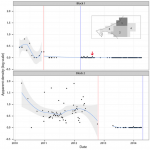The New Weapon Against Disease-Spreading Insects Is Big Data …

Computer models that pinpoint the likely locations of mosquitoes and tsetse flies are helping officials target vector control efforts.
Ploughing the fertile soils of the Niayes region near Dakar in Senegal is still done using beasts of burden—and Big Data is protecting these bovine beasts from an enfeebling malady that’s spread by tsetse flies.
An international research team combined high-resolution maps with advances in species distribution models to simulate the region’s riverine environment. That helped them locate the microhabitats where tsetse flies, which also cause sleeping sickness in humans, were most likely to be found. And that, in turn, allowed the Pan African Tsetse and Trypanosomiasis Eradication Campaign to decide where to place poisoned traps to kill the insects, which was followed up by the strategic release of sterilized males to disrupt surviving flies’ breeding cycles.
“I’m essentially trying to recreate the habitat on the computer,” says Steven Peck, a biomathematician at Brigham Young University who visited Senegal several times to help develop the models.
“Having good maps and having good data, and then collecting data as you go, is absolutely going to change the whole game.”
Similar efforts are already being used to control mosquitoes and agricultural pest species in the United States and in other parts of the world. Such models were used in Brazil to help decide where to release genetically engineered mosquitoes to protect World Cup fans, players, and officials from Dengue fever.
“If you have better information on where the flies or the vectors are, you can specifically target those areas,” Peck says. “One of the things that’s really promising is the use of GIS technology, where they use map-based approaches to recognize habitat using satellites. Having good maps and having good data, and then collecting data as you go, is absolutely going to change the whole game.”
These targeted efforts contrast starkly with some of the destructive methods that were previously used in Senegal to control tsetse flies, which spread parasitic protozoa known as trypanosomes. Former methods included the drenching of vast areas with insecticides and the slaughter of rhinoceroses and hippopotamuses that could help the tsetse flies spread disease.
Computer modeling of one 120,000-acre block of tsetse fly-infested land, dubbed Block 2 by the research team, for example, revealed that just 20,000 acres contained suitable habitat for the tsetse flies. These 20,000 acres were projected to contain the specific temperatures and tree shade where the flies like to rest between blood-hunting expeditions. So it was within these 20,000 acres that traps were deployed and sterilized males released.
The results of the eradication effort in Block 1 and Block 2 of the experimental fields are shown in the following chart, which was included in a paper published last week in the Proceedings of the National Academy of Sciences. The y-axis is a logarithmic scale of the estimated density of each block’s tsetse fly population. The red lines show when poisoned traps were deployed. The blue lines show when sterilized males were strategically released to block the survivors from breeding. The red arrow shows when the last wild fly was captured in Block 1.
(Chart: PNAS)
Jump to original:
The New Weapon Against Disease-Spreading Insects Is Big Data …

